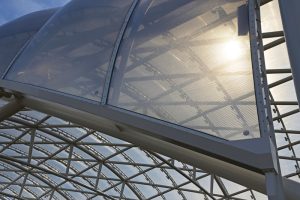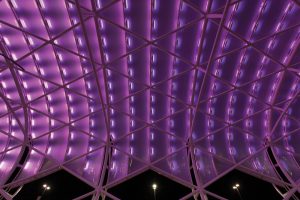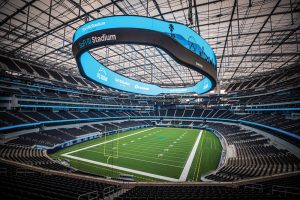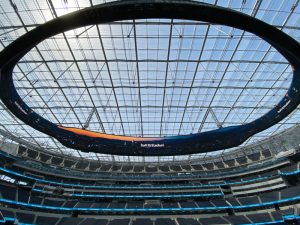Over the past few years, a clear trend has emerged in major sports facility designs in the form of lightweight, transparent, and translucent materials for roofing and façade applications.

Recently constructed state-of-the-art facilities for the National Football League and Major League Soccer have included transparent and translucent foil membranes as the roofing and/or façade material of choice. Additionally, several proposed roofed ballparks in Major League Baseball are also reviewing the materials.

Transparent materials are developing to incorporate higher mechanical strength and better thermal performance. To date, ethylene tetrafluoroethylene (ETFE), in particular, has captured the imaginations of stadium owners, engineers, and designers and has become the material of choice.

The benefit of ETFE roof and façade applications is that they create an authentic, outdoor atmosphere in an indoor, conditioned space, providing a protected and temperature-controlled experience. In addition, the material is lightweight, reducing structural support requirements and costs – especially for long-span roofs – and allowing for lighter, often more elegant structures.
A clear but static roof eliminates the need for mechanization and the operational and maintenance costs of a retractable roof solution. Additionally, abundant natural light can reduce lighting and energy costs during operation.
Limitations and Possibilities
However, conventional ETFE has some significant limitations, including minimal mechanical strength and capacity to support environmental loads due to snow, ponding water, and high winds. As a result, structural elements must be spaced close together, and cable reinforcement is frequently necessary. ETFE also exhibits poor or non-existent intrinsic thermal properties and must be layered and/or fritted to improve thermal performance, substantially compromising the desired clarity. ETFE also has poor acoustic properties, creating challenges with sound management in large spaces.
Fortunately, revolutionary transparent materials are currently being developed to incorporate higher mechanical strength and better thermal performance. Researchers and material specialists at Walter P Moore are partnering with manufacturers to develop better solutions for each new project.
Utilizing a variety of coatings, laminations, and new product applications, the next generation of transparent foil technology will replace conventional ETFE materials with advanced, customizable composite solutions for any project.
Foils that provide enhanced strength, clarity, thermal and acoustic performance, customizable colors, and even missile-impact resistance will expand the market into applications typically reserved for glass and metal panels. These new options will allow designers to redefine what is possible in long-span and lightweight structures.
Future Technology
But why stop there? Creating composite cladding foil paves the way for technologies borrowed from aerospace, automotive, and other industries to be included within the material without sacrificing natural light.

Soon, membranes will incorporate nanoparticles to enable electrochromic technology for active shading, thermochromic technology for active infrared radiation reflectivity, active color, and imaging – even transparent solar harnessing.

Electrochromic technology, currently used in energy-efficient “smart” windows in buildings and rearview mirrors in automobiles, will transform membranes from transparent to opaque with electric current and could be used to black out otherwise clear roofs for concerts or other live shows.
Thermochromic technology, which can selectively target specific wavelengths of infrared radiation, will control solar heat transmission while filling the space with the full visual spectrum of natural light.
Eventually, nanotechnologies employing particles triggered by surface temperature will enable venue owners in colder climates to allow heat to enter the space in winter but then reflect heat in the summer. For those in warmer climates, the technology could allow latent heat built up during the day to escape during cooler night hours.
As light-emitting diodes (LEDs) become smaller and more efficient, nano-LEDs may be applied directly to a composite foil membrane. Organic light-emitting diodes (OLEDs), where the illuminating layer is a film that emits light in response to an electric current, may allow the material itself to become the light source. As LED and OLED technology develops and is adequately scaled, image projection within the material may allow for branding, advertising, and even live-action broadcasting directly from the membrane.
Finally, transparent solar harnessing, which will essentially employ the entire membrane as a giant photovoltaic panel, may eventually be used to supply energy for the entire venue and perhaps the surrounding community.
While there have been relatively few innovations in long-span roof design in the last several years that have significantly altered the landscape, materials research and development around lightweight, transparent roofing and façade materials may prove truly game-changing.■
